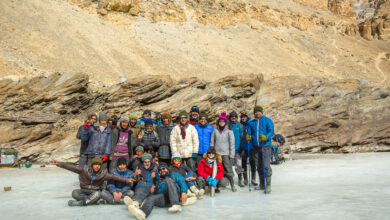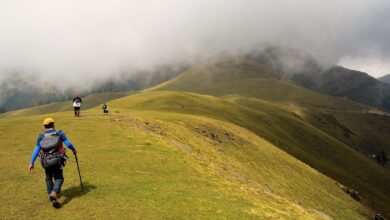Chardham Yatra with Valley of Flowers: A Spiritual and Natural Odyssey
Introduction
Nestled in the heart of the Indian Himalayas, the Chardham Yatra is a sacred pilgrimage that draws millions of devotees seeking spiritual solace and divine blessings. Comprising four revered shrines—Yamunotri, Gangotri, Kedarnath, and Badrinath—this pilgrimage is as much a journey of faith as it is an exploration of some of the most breathtaking landscapes in India. Adding to this sacred odyssey is the enchanting Valley of Flowers, a UNESCO World Heritage Site known for its breathtaking meadows of endemic flora, set against the backdrop of towering peaks. This article delves into the significance, routes, and experiences that make the Chardham Yatra complemented by a visit to the Valley of Flowers an unforgettable adventure.
The Spiritual Significance of Chardham
Yamunotri
Yamunotri, the source of the Yamuna River, is the westernmost shrine of the Chardham. Nestled at an altitude of 3,293 meters, it is revered as the seat of Goddess Yamuna. Pilgrims embark on a trek of about 13 kilometers from Hanuman Chatti to reach the temple. The region is characterized by its hot springs, and devotees often take a dip in the sacred waters, believing it to cleanse them of sins.
Gangotri
Gangotri, the origin of the River Ganges, holds immense spiritual importance for Hindus. The temple dedicated to Goddess Ganga is situated at an altitude of 3,048 meters. Pilgrims often carry water from the Ganges back to their homes as a blessing. The scenic trek to Gangotri, often through dense forests and alongside the roaring Bhagirathi River, enhances the spiritual experience.
Kedarnath
Kedarnath, dedicated to Lord Shiva, is one of the twelve Jyotirlingas. Situated at a height of 3,583 meters, it is accessible via a trek of about 16 kilometers from Gaurikund. The Kedarnath Temple, which dates back to the 8th century, is a marvel of ancient architecture and attracts devotees year-round. The journey to Kedarnath is often considered a test of faith, with the majestic Kedarnath peak watching over the devotees.
Badrinath
The final destination, Badrinath, is dedicated to Lord Vishnu and is located at an altitude of 3,133 meters. The Badrinath Temple, one of the most important pilgrimage sites in India, is known for its vibrant architecture and the sacred statue of Lord Vishnu. Surrounded by the Nar and Narayan mountain ranges, the temple exudes a divine aura that captivates every visitor.
The Valley of Flowers: A Natural Wonderland
Introduction to the Valley
The Valley of Flowers is a national park situated in the Western Himalayas, famous for its alpine flora. Spanning over 87.5 square kilometers, this valley bursts into color during the monsoon season, transforming into a lush carpet of flowers. Declared a UNESCO World Heritage Site in 2005, it is a haven for botanists, nature enthusiasts, and adventure seekers alike.
Flora and Fauna
Home to over 500 species of flowering plants, the Valley of Flowers showcases a stunning variety of flora including blue poppies, primulas, and various species of orchids. This biodiversity is crucial for sustaining the ecosystem and supports a range of fauna, including snow leopards, musk deer, and numerous bird species.
Trekking and Accessibility
The valley is accessible from Joshimath, where trekkers typically begin their journey. The trek to the Valley of Flowers is approximately 17 kilometers from Ghangaria, the base camp for both the Valley of Flowers and Hemkund Sahib. The well-marked trails meander through picturesque landscapes, offering stunning views of snow-capped peaks and cascading waterfalls.
Planning Your Chardham Yatra
Best Time to Visit
The ideal time for the Chardham Yatra is between late April and early November, coinciding with the summer months in India. The Valley of Flowers is particularly vibrant from mid-July to early September, making it an ideal addition to your pilgrimage.
Accommodation and Facilities
Various accommodation options, ranging from budget guesthouses to luxury hotels, are available in places like Haridwar, Rishikesh, and Joshimath. Basic facilities are also available near the shrines, although pilgrims are advised to plan their stays in advance, especially during peak season.
Travel Tips
- Physical Fitness: The treks involved can be strenuous; ensure you are physically prepared.
- Altitude Sickness: Be aware of altitude sickness, especially at Kedarnath and Badrinath. Acclimatization is essential.
- Weather Preparedness: The weather can be unpredictable. Carry suitable clothing for both warm days and chilly nights.
- Eco-Consciousness: Respect the environment. Carry back any waste and minimize your impact on the fragile ecosystems.
The Spiritual Experience
Connecting with Nature
The Chardham Yatra is not just about visiting temples; it’s an immersion in the breathtaking beauty of the Himalayas. The serene landscapes, rushing rivers, and majestic peaks create a spiritual ambiance that fosters introspection and connection with the divine. The Valley of Flowers adds a layer of serenity and awe, where the vivid colors and fragrances invite deep contemplation.
Pilgrimage and Community
The journey often brings together people from diverse backgrounds, united in their faith. The shared experience of trekking, praying, and celebrating creates a sense of community among pilgrims. Festivals and local traditions enrich this experience, as devotees participate in rituals and celebrations at each shrine.
Personal Transformation
Many pilgrims return from the Chardham Yatra with a renewed sense of purpose and clarity. The challenges faced during the trek, combined with moments of tranquility and devotion, contribute to personal growth and spiritual awakening.
Conclusion
The Chardham Yatra, complemented by a visit to the Valley of Flowers, offers a unique blend of spirituality and natural beauty. It is a journey that transcends the physical realm, inviting participants to connect with their faith, the environment, and themselves. Whether you seek divine blessings, adventure, or simply a moment of peace amidst nature’s splendor, this pilgrimage promises an experience that lingers in the heart and soul long after the journey ends.
As you embark on this odyssey, remember that it’s not just the destinations but the journey itself—the people you meet, the challenges you overcome, and the beauty you witness—that truly enriches the Chardham Yatra and the Valley of Flowers. May your pilgrimage be filled with joy, inspiration, and divine blessings.


